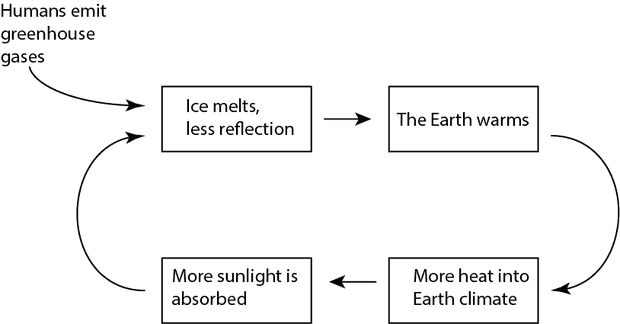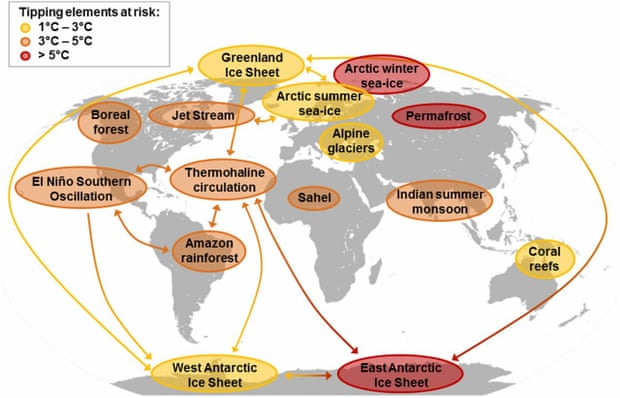A new paper, just published in the Proceedings of the National Academy of Sciences has received a lot of media attention. The attention is justified because the paper paints a very grim picture of the climate and what humans may be doing to it. In particular, the authors of this study tried to determine the trajectory that the Earth is on so we can predict what the future climate will be.
There are many really important insights from this paper. The authors wanted to know how feedbacks in the Earth’s climate will play a role in shaping the climate in the future. By feedbacks, we mean a change in one part of the climate that then causes another change, which in turn may cause another change, and so on, potentially setting up chain reactions.
Feedbacks are really important because they are changes that the natural system makes without being caused directly by humans.
For example, melting ice is one feedback, particularly in the Arctic. Humans have emitted greenhouse gases that have caused the Earth to warm. As the Earth warms, ice melts; as ice melts, it means there is less white reflective cover on the Earth surface. In fact, a lot of this ice melting is happening in the Arctic. Instead of having a white surface that reflects sunlight, we have open ocean water that absorbs sunlight. Consequently, melting of ice leads to more absorbed sunlight which then leads to more melting of ice – a reinforcing cycle, as illustrated below.

Melting ice positive feedback cycle diagram. Illustration: John Abraham
Activating one of these cycles is bad news for a few reasons. First, it takes away a lot of control of the Earth’s climate from us. Right now, humans control the climate through our emissions of greenhouse gases. But once these cycles get activated, the Earth’s climate will partially control itself. That means it will be harder to stop the warming process.
The second reason this is bad news is that many of the cycles are linked together. For instance, the feedback cycle shown above might be strong enough to activate another cycle (for example, melting of permafrost and release of trapped methane). So, you can’t look at these feedbacks in isolation. You have to consider how they behave as a group.
The image below is taken from the paper. It shows 15 different feedback cycles. They are colored by the temperature at which they will be triggered. For instance, the authors believe the Greenland ice sheet will be activated when temperatures rise 1–3°C. The East Antarctic ice sheet however, shown at the bottom, will be activated once temperatures rise by 5°C or more.
The various feedbacks also have connecting arrows to show how they are interrelated. For instance, there is an arrow connecting the Greenland Ice Sheet and Arctic summer sea ice. This means the two feedbacks affect each other.

Map of potential tipping cascades. Illustration: Steffen et al. 2018, Proceedings of the National Academy of Sciences
This image is really important for understanding why scientists are so worried. Consider the summer Arctic sea ice. We know that it has decreased by about 70% in volume and perhaps 50% or so in area. Loss of Arctic sea ice will affect the Greenland Ice Sheet. That in turn will affect the West Antarctic Ice Sheet.
It doesn’t stop there;
from Skeptical Science https://ift.tt/2L1OwYf
A new paper, just published in the Proceedings of the National Academy of Sciences has received a lot of media attention. The attention is justified because the paper paints a very grim picture of the climate and what humans may be doing to it. In particular, the authors of this study tried to determine the trajectory that the Earth is on so we can predict what the future climate will be.
There are many really important insights from this paper. The authors wanted to know how feedbacks in the Earth’s climate will play a role in shaping the climate in the future. By feedbacks, we mean a change in one part of the climate that then causes another change, which in turn may cause another change, and so on, potentially setting up chain reactions.
Feedbacks are really important because they are changes that the natural system makes without being caused directly by humans.
For example, melting ice is one feedback, particularly in the Arctic. Humans have emitted greenhouse gases that have caused the Earth to warm. As the Earth warms, ice melts; as ice melts, it means there is less white reflective cover on the Earth surface. In fact, a lot of this ice melting is happening in the Arctic. Instead of having a white surface that reflects sunlight, we have open ocean water that absorbs sunlight. Consequently, melting of ice leads to more absorbed sunlight which then leads to more melting of ice – a reinforcing cycle, as illustrated below.

Melting ice positive feedback cycle diagram. Illustration: John Abraham
Activating one of these cycles is bad news for a few reasons. First, it takes away a lot of control of the Earth’s climate from us. Right now, humans control the climate through our emissions of greenhouse gases. But once these cycles get activated, the Earth’s climate will partially control itself. That means it will be harder to stop the warming process.
The second reason this is bad news is that many of the cycles are linked together. For instance, the feedback cycle shown above might be strong enough to activate another cycle (for example, melting of permafrost and release of trapped methane). So, you can’t look at these feedbacks in isolation. You have to consider how they behave as a group.
The image below is taken from the paper. It shows 15 different feedback cycles. They are colored by the temperature at which they will be triggered. For instance, the authors believe the Greenland ice sheet will be activated when temperatures rise 1–3°C. The East Antarctic ice sheet however, shown at the bottom, will be activated once temperatures rise by 5°C or more.
The various feedbacks also have connecting arrows to show how they are interrelated. For instance, there is an arrow connecting the Greenland Ice Sheet and Arctic summer sea ice. This means the two feedbacks affect each other.

Map of potential tipping cascades. Illustration: Steffen et al. 2018, Proceedings of the National Academy of Sciences
This image is really important for understanding why scientists are so worried. Consider the summer Arctic sea ice. We know that it has decreased by about 70% in volume and perhaps 50% or so in area. Loss of Arctic sea ice will affect the Greenland Ice Sheet. That in turn will affect the West Antarctic Ice Sheet.
It doesn’t stop there;
from Skeptical Science https://ift.tt/2L1OwYf

Aucun commentaire:
Enregistrer un commentaire